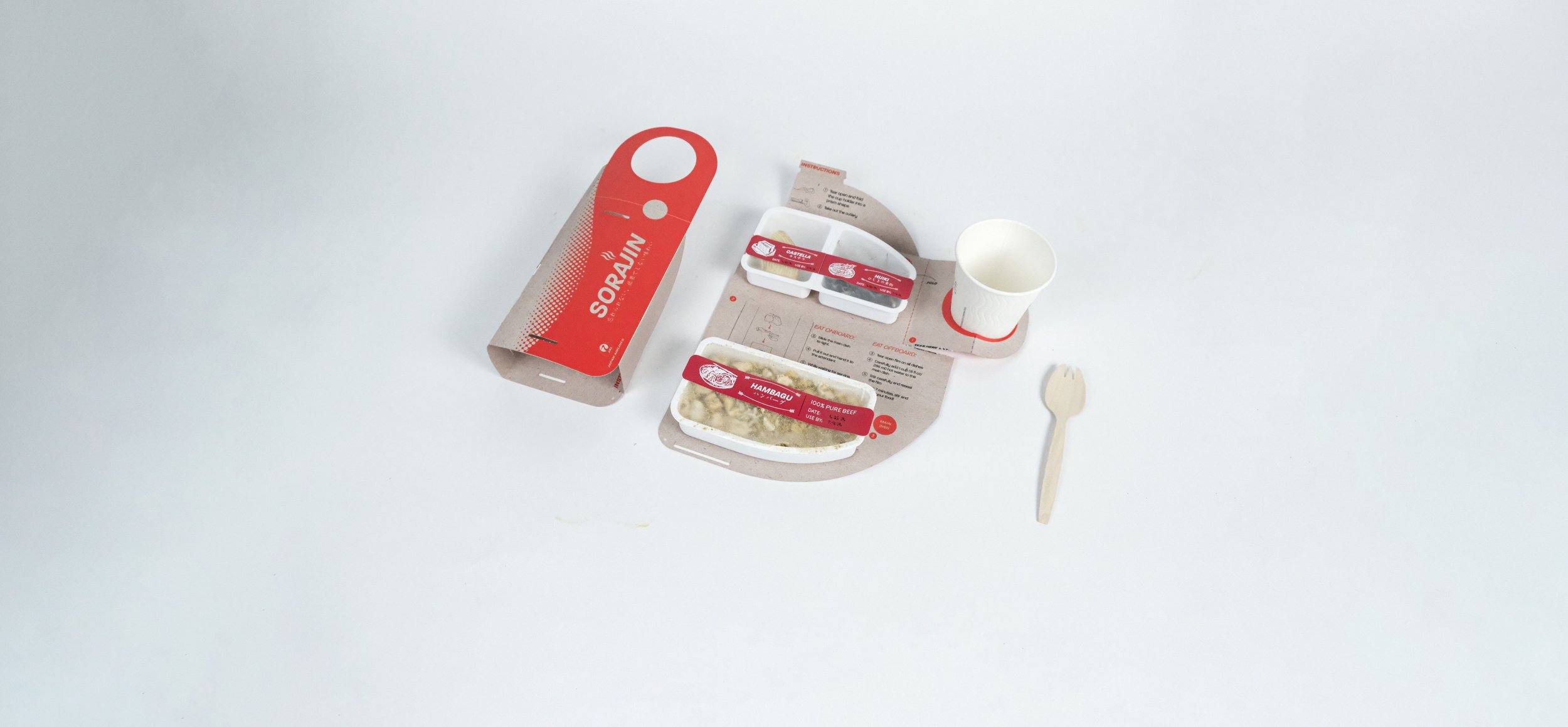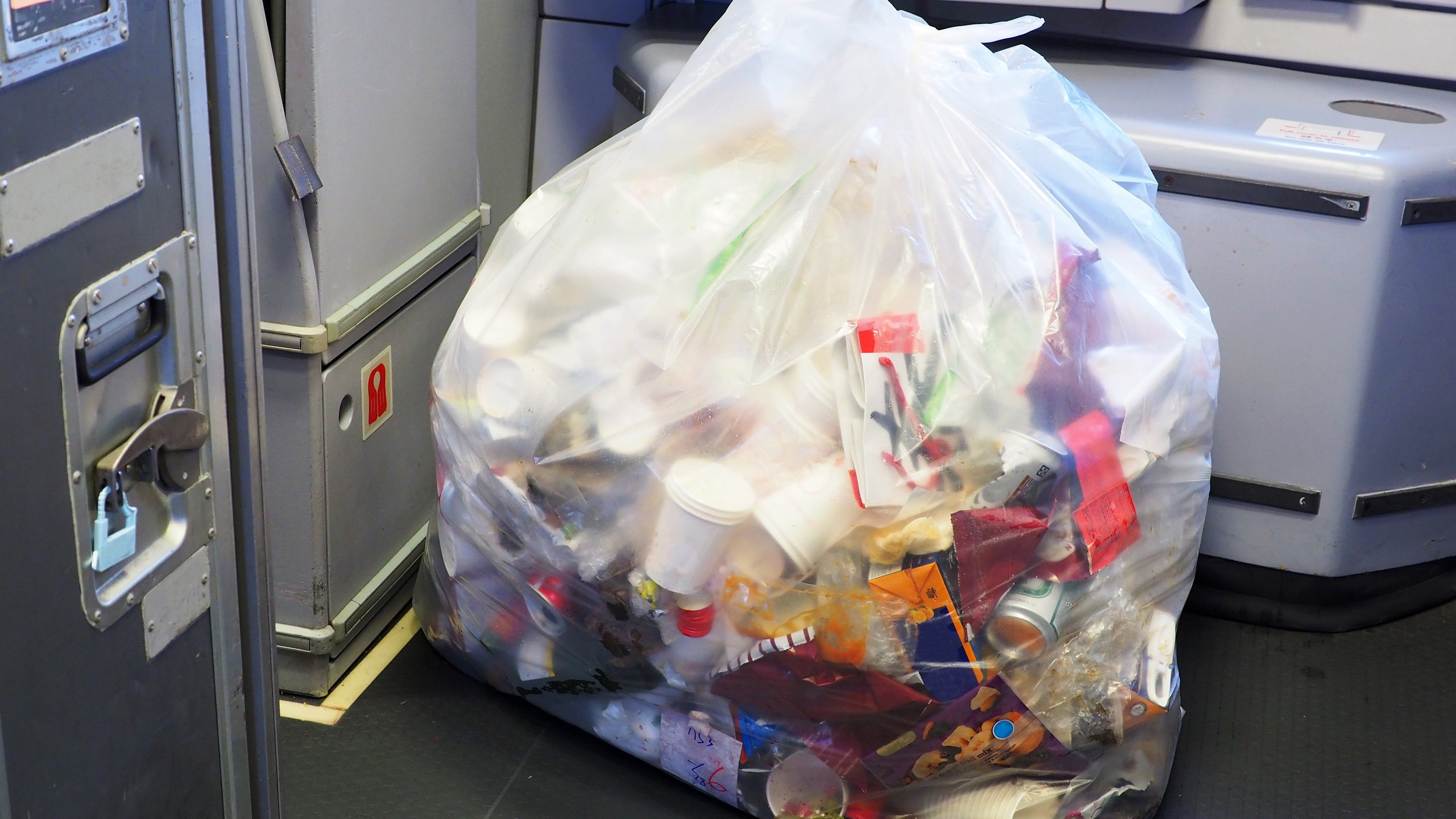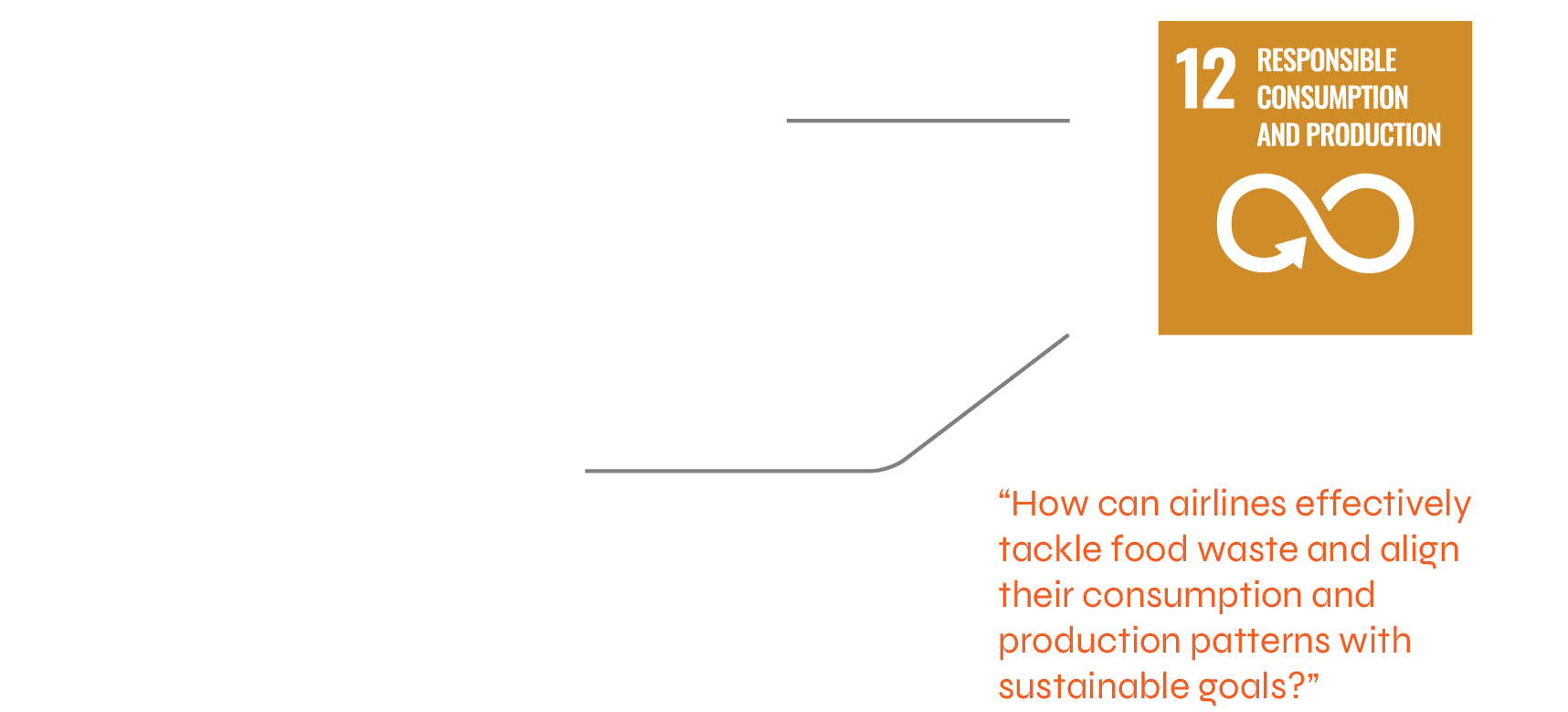
Unforgettable Journey Unedning Flavors
Field: Product Design / Service Design
Duration: 4 Months Year: 2024
Software Used
Experience the future of economy class with Sorajin‘s freeze-dried meals. Designed for long-haul flights, Sorajin combines sustainability with dining flexibility, allowing passengers to savor their meals onboard or take them for later enjoyment. Packaged in recyclable materials, Sorajin not only reduces food waste but also elevates your dining experience.
How it works
Carrying Consideration
The packaging design features a cut-out handle, allowing passengers to easily carry their meals. This handle ensures that the meal package is convenient to transport, yet remains compact enough to fit neatly into the front pouch of an airplane seat. This design consideration maximizes ease of use while accommodating the limited space available in cabin seating.
No-adhesive assembly
The packaging incorporates a tuck-and-secure feature that eliminates the need for adhesive in assembling the containers, simplifying recycling process.
Folding cup folder
The packaging is engineered to incorporate a three-dimensional cup holder, constructed from a single layer of material. This feature ensures stability without the need for additional materials, enhancing the product’s sustainability by minimizing material use
Menu Selection
entree
Dessert
Sorajin’s menu offers diverse protein options with standard appetizers and desserts, ensuring passengers can enjoy a full-course meal tailored to their dietary preferences. This variety caters to all tastes, making mealtime a journey highlight.
In-flight entertainment interface
home
introduction
The UI/UX design integrates with the in-flight entertainment system, enhancing dining by offering dish details and a countdown timer for meal rehydration. A live interaction feature fosters a communal dining atmosphere, enriching the in-flight experience and connecting passengers.
entree detail
Appetizer detail
Dessert Detail
Countdown timer reminds passenger how much left before they can enjoy the meal
Quick response buttons allow passengers to interact without typing, encouraging fast and easy engagement with others.
Waste in the cloud
The International Air Transport Association (IATA) research indicates that over 20% of cabin waste comprises untouched food and drink and with in-flight catering market of $15 billion in 2017, this represents a significant incentive to improve planning and logistics. Food waste is emerging as a global issue with up to one third 1.3 billion tonnes lost or wasted each year.
Beyond taste
According to research article, “Why Is Airline Food Always Dreadful? Analysis of Factors Influencing Passengers’ Food Wasting Behaviour,” researchers applied design for sustainable behavior framework to analyze passengers’ food wasting behavior and investigated factors associated with their food wasting behaviors, understanding the of user behavior formation helps to identity key factors of behavioral change.
First Hand Experience insight
Rail to space gourmet
In China, their approach to enhancing the train dining experience involves leveraging technology to offer passengers the convenience of ordering food online for delivery at their next station. This system not only modernizes the train dining experience but also opens up a wide variety of meal options, reflecting an innovation integration of technology to traditional travel. Addressing logistical challenges with dining on the move through digital solutions is an innovative approach to maximize passengers’ experience with convenience and food variety.
On the journey of redefining the in-flight dining experience, I went beyond the confines of aviation industry to explore dining practices in similarly contexts.
Exploring culinary innovation led me to space food, where gravity constraints make meal preparation and preservation crucial. I discovered how space food evolved from canned meals to freeze-dried and dehydrated options, creating shelf-stable, nutrient-rich meals fit for space travel. This preservation method now has meaningful applications on Earth, with freeze-dried food gaining popularity for camping and as a quality alternative to long-prepared meals, marking a shift from purely ‘functional’ to desirable cuisine.
Muji, known for its minimalist design and sustainability, has launched a popular line of freeze-dried foods, from soups to main dishes. This collection showcases how freeze-drying can create shelf-stable foods without compromising taste or nutrition. The success of Muji’s line, alongside brands like PeakRefuel, Mountain House, and Patagonia Provisions, highlights the potential of freeze-dried food in reducing waste, improving meal storage, and supporting a sustainable future.
The rich tradition of ekiben (railway lunch boxes) in Japan’s railway system fascinates me. For Japanese travelers, train journeys are incomplete without ekiben, which combines local culinary traditions, sustainability, and innovative service. This holistic approach offers a model for redefining airplane dining, making meals an integral part of the travel experience. Rooted in regional pride, ekiben showcases how food transcends mere sustenance, turning dining into a cultural immersion. Each box represents its region, supporting the One-Village-One-Product movement by promoting local ingredients and sustainable development.
problem reframing
Target client
From these research, it has highlighted a critical issue: The natural variability in passengers’ dining preferences and timing significantly contributes to food waste on flights, leading to an escalating environmental impacts and posing substantial challenges to airlines’ sustainability efforts. This variability leads to inefficiencies in meal distribution and consumption, where unused or partially used meals become waste, thus increasing the carbon footprint and operational costs associated with in-flight services.
To develop on the concept, I decided to choose an airline company that aligns with my mission to address food waste and advocate sustainability initiatives. Japan Airlines serve as an excellent choice because they are one of the few airline companies that promotes the effective use of limited resources.
Design objective
Sorajin aims to address these challenges by introducing an innovative meal service solution adapts to the diverse dining preferences and varying timing needs of passengers.
1. Left & Middle, the 4Rs (Reuse, Reduce, Reuse, Recycle) initiative is deeply implemented in the business to reduce food waste and eliminate single-use plastic products.
2. Right, the meal skip option service allows passengers to opt-out from meals if choose not to eat onboard.
Concept Ideation
Ideating on different stages of dining experience on airplane to expand on the possibitlies of product that exist in the overall user experience. Mix and matching ideas to challenge myself to ideating beyond what’s existing on airplane.
Design Concept
Concept I: HydroBento Service
Concept II: Dining Companion
Concept III: Smart Tray System
A bento-style, packaging as a meal tray, concept that introduces the idea of freeze-dried food to enhance flexibility, allowing passengers to savor their meal on airplane or take them for later enjoyment. A new service is paired with the concept where attendants assist in rehydrating the food in a step of peeling the cover film, pouring hot water, re-covering the film, and placing it onto meal tray.
A gadget that enables passengers to select meals and beverages pre-flight, with a feature of pairing recommendations, while enhancing the dining atmospheres with ambient lighting emitted from the device to mimic the cozy ambiance of candlelit dining, turning mealtime into a mood-boosting event.
A redesigned meal tray with technology enabled to elevate dining experience onboard. The tray is equipped with NFC or RFID tag that triggers sound and visual experience when place onto the tray table, as if passengers are enjoying the meal in restaurant. The tags are programmed and that it will play the corresponding sound and visuals that fits the type of meal chosen by passengers.
Form Exploration
Form exploration is key to this product’s aesthetic, moving beyond the typical rectangular bento box to create welcoming, organic shapes that retain functionality. The design aligns with Japan Airlines’ clean, modern aesthetic, offering soothing, functional forms.
Prototyping & User testing
Early prototypes underwent testing to optimize cutting patterns for easy folding and ensure the product lays flat when unfolded. Various cup holder designs were also tested for material efficiency. The version above was then refined and engineered into an improved solution.
Early prototypes were tested onboard to assess compatibility with cabin layout, focusing on size, user flow, and seamless integration into the passenger experience. This phase provided insights for necessary adjustments to optimize functionality.
Freeze-dried food
Food selection in Sorajin is key, with freeze-dried meals transforming the in-flight dining experience for passengers and catering, reshaping meal preparation, service, and enjoyment onboard.
Rehydrate freeze-dried food with hot water and stir to mix it well.
Seal and wait 5 minutes to fully rehydrate and heat up the food
To ensure quality, I personally tested freeze-dried meals from brands like Muji and MountainHouse, sampling items like Muji’s soup and MountainHouse’s beef stroganoff. Initially skeptical, I was impressed by the flavor and texture, leading me to adopt this concept for sustainable in-flight meal options.

Sustainable Materials
Streamlined Production
Every step in production is designed to enhance traditional meal prep without adding complexity. Graphics are printed inside and out, followed by die cutting and creasing for form. Containers and cutlery are easily integrated, with a final stamp labeling the meal type, streamlining the assembly process efficiently.
Service blueprint
The introduction of Sorajin changes the traditional service model. Instead of full meal carts, stewards will now provide hot water for rehydrating meals, simplifying the service process and reducing waste. Red boxes label the changes in service.
Final Deisgn Feedback
To evaluate its real-world application, I sent a Sorajin prototype to potential users and tested it with flight attendants during a flight. This approach provided valuable feedback on Sorajin’s practicality and user-friendliness from both passenger and crew perspectives, helping refine the design to meet users’ needs effectively.
What’s Next
Looking ahead, Sorajin is designed to set a new standard in sustainable dining across global airlines, extending beyond Japan Airlines. Its adaptable design aligns with various airline brands while upholding core environmental and functional values. I envision Sorajin driving a global shift toward more sustainable in-flight dining experiences.

















































































